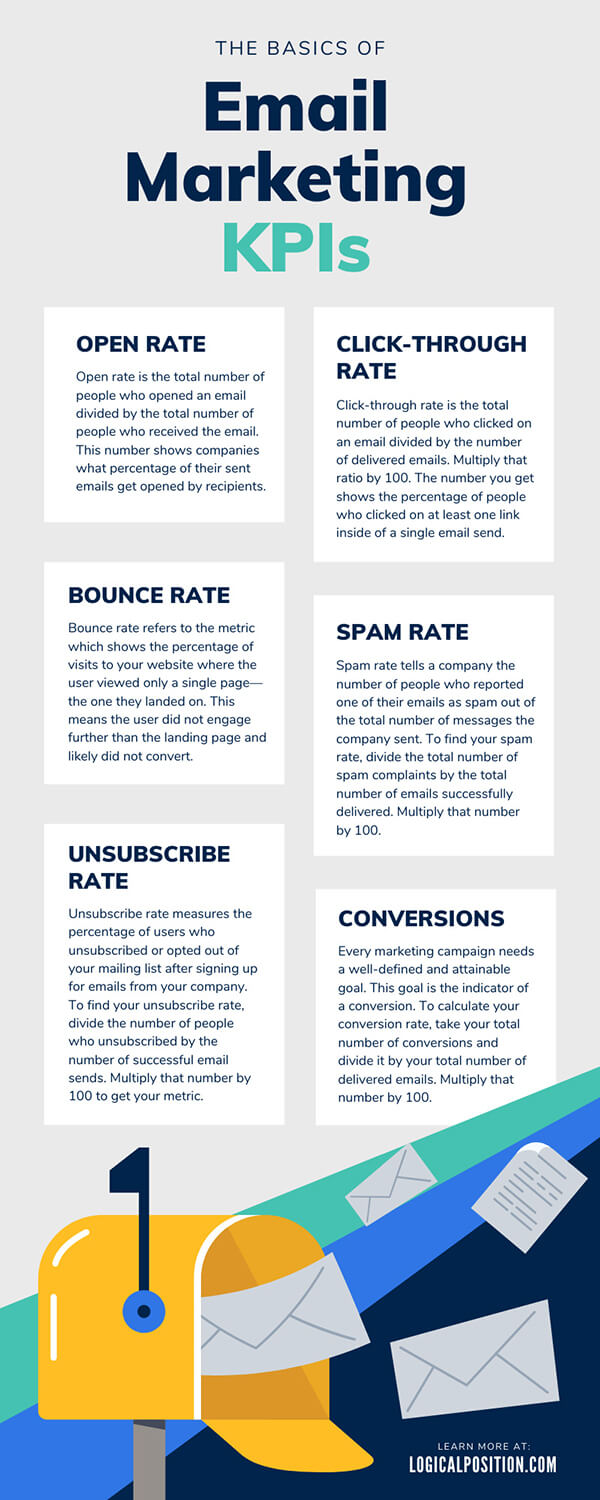Email marketing is well-renowned as one of the digital marketing forms with a high return on investment. It targets people who are already aware of your brand and have built an initial trust. In an email, you are capturing a return or pre-trusting audience.
Without those walls to break down, you can focus on creating conversions and bringing people back to your website. To get started in email marketing, you must understand the basics of email marketing KPIs (key performance indicators).
While it’s important to note that KPIs differ from company to company due to changes in goals, these are the most important ones to keep an eye on—regardless of your objective.
- Open Rate
- Click Rate
- Bounce Rate
- Unsubscribe Rate
- Spam Rate
- Conversions
- Revenue per send
Open Rate
Open rate is the total number of people who opened an email divided by the total number of people who received the email. This number shows companies what percentage of their sent emails get opened by recipients.
Why It Matters
Open rate helps to provide a baseline of how strong your audience is and how your campaign appeals to that audience. If you have high open rates, but you lack click rate, it could indicate that your subject lines are effective but potentially do not accurately represent what is in the email once opened.
It can also indicate which of your subscribers are active and which may no longer fit with your company’s sends. Identifying these non-active users can help when it comes time to purge your list of passive subscribers.
Click-Through Rate
Click-through rate is the total number of people who clicked on an email divided by the number of delivered emails. Multiply that ratio by 100. The number you get shows the percentage of people who clicked on at least one link inside of a single email send.
Why It Matters
Click-through rate is a vital metric in nearly all forms of digital marketing. In email marketing, its significance is to show companies general trends. It can help establish the effectiveness of subject lines, copy, design, and visual aspects within the email, and more in capturing user attention.
Pro-Tip: Avoid over counting clicks by ensuring your system only counts one click per person. For example, if person A clicks on two links in one email, that person should still only count as one-click for calculations. Otherwise, you are calculating the total click-through rate, not the click-through rate.
Bounce Rate
Bounce rate refers to the metric which shows the percentage of visits to your website where the user viewed only a single page—the one they landed on. This means the user did not engage further than the landing page and likely did not convert.
Why It Matters
The bounce rate matters because it indicates the quality of your website and landing pages. Ideally, companies should aim for a very low bounce rate. High bounce rates indicate that your website might offer a poor user experience for any number of reasons. Here are the most common:
- The website is not mobile-friendly.
- The landing page does not appeal to the target audience.
- The website loads slow or is outdated in design.
- The landing page is not related to the email or the anchor text.
Unsubscribe Rate
Unsubscribe rate measures the percentage of users who unsubscribed or opted out of your mailing list after signing up for emails from your company. To find your unsubscribe rate, divide the number of people who unsubscribed by the number of successful email sends. Multiply that number by 100 to get your metric.
Why It Matters
Every email campaign experiences unsubscribers. People unsubscribing could be for reasons entirely unrelated to the campaign, and very low unsubscribe rates are nothing to worry about. High unsubscribe rates can be concerning, however. A high unsubscribe rate indicates that either the email content is not matching up with consumer expectations or your sends are far too frequent.
A good goal for email marketing is to keep your subscriber list consistent in numbers or to grow it—never in decline. A low unsubscribe rate is made up for by a matching or higher signup rate.
Spam Rate
Spam rate tells a company the number of people who reported one of their emails as spam out of the total number of messages the company sent. To find your spam rate, divide the total number of spam complaints by the total number of emails successfully delivered. Multiply that number by 100.
Pro-Tip: A spam rate of less than 0.05 percent is ideal. Any higher than this, and your company risks future sends not making it to its subscribers’ inboxes.
Conversions
The conversion rate in email marketing is similar to conversion rates in other areas of digital marketing. Every marketing campaign needs a well-defined and attainable goal. This goal is the indicator of a conversion. To calculate your conversion rate, take your total number of conversions and divide it by your total number of delivered emails. Multiply that number by 100.
Why It Matters
Conversion rate tells a company how well their email marketing efforts are working to meet their goals. Knowing your conversion rate helps determine your return on investment. Here are a few examples of what businesses define conversion as.
Note: define your conversion clearly and with a singular definition.
- Buy a product
- Sign up for a service
- Download a resource
- Call the company
- Sign up for a consultation

How Logical Position Can Help
Logical Position is a professional digital marketing agency. We offer targeted email marketing services using a dedicated approach that puts our clients’ needs first. Running an experienced and successful email marketing campaign with the highest possible return on investment takes tons of time and expertise.
With a professional agency such as Logical Position, you can rely on a dedicated staff that works closely with you every step of the way to ensure positive growth in your conversion rates. Contact us today for a free consultation on our email marketing services.




